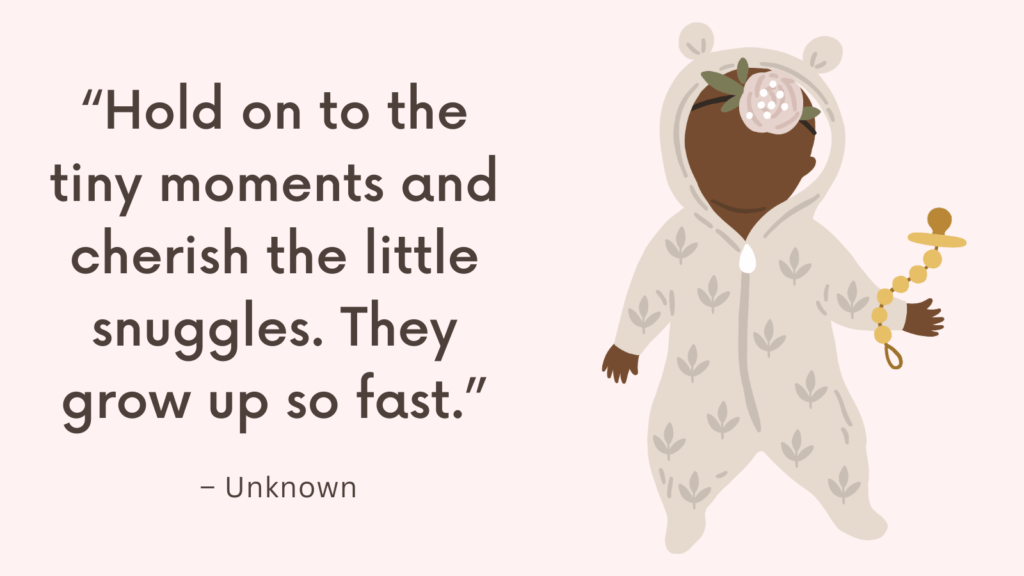In this post, you’re going to discover alternatives to swaddling.
Definition of Swaddling
Swaddling is the practice of wrapping a baby in a tight blanket or cloth to provide a sense of comfort and security.
It is primarily used during the first few months of a baby’s life to help them feel secure and calm.
Swaddling limits the movement of the baby’s limbs and can also help prevent the startle reflex, which can wake a sleeping baby.
However, it is important to follow proper swaddling techniques to ensure the baby’s safety and avoid overheating.
Related: Receiving Blanket vs Swaddle
Why Some Parents May Look For Alternatives to Swaddling?
There are several reasons why some parents may look for alternatives to swaddling:
1. Baby’s preference: Not all babies like to be swaddled. Some babies feel restricted and claustrophobic in swaddle blankets.
2. Health concerns: Swaddling may increase the risk of hip dysplasia, a condition where the hip joint isn’t properly positioned. Although swaddling done correctly may not cause any harm, doctors advise caution when swaddling infants who are at risk of developing hip dysplasia. (source)
3. Age: As babies grow and develop, they become more active and might naturally resist being swaddled.
4. Climate: Swaddling can be too warm for babies in hot weather and may increase the risk of overheating.
Overall, each baby is unique, and parents should choose what works best for their child.
Related: 10 Best Books For New Moms
Risks of Swaddling
While swaddling can be comforting for some babies, it does come with some risks.
Here are a few:
1. Overheating: When swaddled, babies may become too hot, which can lead to dehydration and overheating.
2. Hip dysplasia: Swaddling too tightly or with the legs straight can cause hip dysplasia in some babies, especially if they are already at risk due to family history or breech positions. (source)
3. SIDS: Swaddling has been associated with an increased risk of sudden infant death syndrome (SIDS) in some studies. The exact reason for this link is unclear, but it may have to do with overheating or restricted breathing. (source)
4. Failure to thrive: If you swaddle your baby too tightly or for too long, they may not move around as much, which can lead to delayed development, muscle weakness, and failure to thrive.
It is important to swaddle your baby safely to prevent these risks.
Always use a lightweight blanket, keep the swaddle loose enough for your baby to move their legs freely, and stop swaddling as soon as your baby begins to roll over on their own.
Related: Best 10 Newborn Care Books
Alternatives to Swaddling to Soothe Your Baby
Swaddling can be a great way to soothe and calm babies, but there are alternative methods that can also be effective:
#1. Swaddle Transition Products
Swaddling transition products are often used when babies grow or start to dislike being swaddled.
This can make these products a good alternative to swaddling.
Here are some popular swaddling transition products:
1. Sleep sacks: These are wearable blankets that keep your baby cozy and warm without the need for swaddling. They come in a variety of styles, materials, and sizes, so you can choose one that fits your baby’s needs.
2. Swaddle wraps: These are similar to swaddles, but feature adjustable wings with Velcro or snaps that allow you to gradually loosen the wrap and eventually remove it altogether.
3. Zip-up swaddles: These are also known as “arms up” swaddles, which keep your baby’s arms up near their head, but still give them enough room to move around.
4. Transitional swaddles: These are designed specifically for babies who are in the process of transitioning out of a swaddle. They usually come with adjustable wings or zippers that can be removed over time, so your baby can gradually get used to sleeping without a swaddle.
Remember that every baby is different, and what works for one may not work for another. It’s important to pay attention to your baby’s cues and preferences, and adjust accordingly.
Related: Top 17 Questions To Ask A Doula
#2. Co-Sleeping
Co-sleeping can be a good alternative to swaddling, as it allows the baby to feel more secure and close to the parent.
Co-sleeping involves having the baby sleep in the same bed as the parent or in a separate co-sleeping bassinet attached to the bed.
This can help the baby feel more relaxed and calm, as they can hear and feel the parent’s breathing and heartbeat.
However, it is important to ensure safe sleeping practices while co-sleeping.
The American Academy of Pediatrics recommends that parents follow the “ABCs” of safe sleep:
- A for Alone: The baby should sleep alone without any other objects in the sleeping area.
- B for Back: The baby should always be placed on their back to sleep.
- C for C rib: The baby should sleep in a crib or bassinet with a firm mattress and tight-fitting sheet.
(source)
Parents should also avoid co-sleeping if they are under the influence of drugs or alcohol, as this can increase the risk of accidental suffocation or other dangers to the baby. (source)
If you choose to co-sleep, make sure to discuss this decision with your pediatrician and follow safe sleeping guidelines to help ensure the safety of your baby.
Related: Best 70 Pregnancy Hacks (+Products Recommendation)
#3. Baby Wearing
This involves carrying your baby in a sling or carrier that is close to your body while being hands-free.
The feeling of warmth and closeness can be calming for babies.
Baby wearing is a great alternative to swaddling and has been practiced for centuries in many cultures around the world.
Baby wearing has many benefits, including promoting bonding between you and your baby, providing a calming and soothing environment for your baby, and allowing you to go about your daily activities while keeping your baby close and safe. (source)
There are many types of baby carriers and wraps available on the market, so it is important to choose one that is comfortable for both you and your baby, and that provides the right level of support.
Some popular options include ring slings, structured carriers, and wrap-style carriers.
If you are considering baby wearing as an alternative to swaddling, it is always best to consult with your pediatrician to ensure that it is safe for your baby and to get recommendations on the best type of carrier for your individual needs.
Related: Best 7 Pregnancy Self Care Products
#4. White Noise
White noise machines can be an effective alternative to swaddling for helping babies sleep soundly.
These machines create a constant, soothing sound that can help mask environmental noises and create a calming atmosphere for your baby.
There are many different types of white noise machines available on the market, including those that play nature sounds, fan noises, or even simulated womb sounds.
Some models even come with additional features like night lights, lullabies, or timers.
When using a white noise machine, it’s important to keep the volume at a safe level and place the machine at a distance from your baby’s crib to prevent any potential harm.
If you’re unsure about how to properly use a white noise machine with your baby, it’s always best to consult with your pediatrician first.
Related: Minimalist Baby Essentials
#5. Rocking
Rocking can be an effective alternative to swaddling for soothing a baby.
The gentle back-and-forth motion of rocking mimics the movement the baby experienced while in the womb, which can help calm and soothe them.
Additionally, holding your baby during rocking gives them a sense of security and closeness that can also aid in relaxation.
Rocking can be done in a variety of ways, including using a rocking chair, a glider, or simply holding your baby and gently swaying from side to side.
Just be sure to always hold your baby securely and avoid excessive movements that could be jarring or uncomfortable for them.
Related: 10 Tips For Successful Breastfeeding
#6. Pacifiers
Pacifiers can be a helpful tool for soothing babies, especially when they are fussy or having trouble sleeping.
When using a pacifier, it’s important to make sure it is age-appropriate and sized correctly for your baby.
You should also monitor its use to prevent any potential safety concerns, such as choking hazards.
In addition to pacifiers, there are other techniques you can try to soothe your baby, including gentle rocking, swaying, or singing.
Experiment with different methods to find what works best for you and your little one.
Related: How To Combine Breastfeeding And Pumping?
#7. Dimming the Lights
One alternative to swaddling a baby is to dim the lights in their sleeping environment.
This can create a calming atmosphere and reduce stimulation for the baby, which may help them sleep more soundly.
Make sure to use dim lighting that doesn’t completely darken the room, as babies need some light to be able to see and recognize familiar objects.
You can also use a night light or a low-level lamp to provide just enough light to comfort the baby without disturbing their sleep.
If you have concerns about your baby’s sleep habits, it’s best to consult with your pediatrician.
Related: How To Sleep Comfortably With Engorged Breasts?
Conclusion
It’s important to note that every baby is different, and what works for one may not work for another.
Experimenting with different methods can help you find what works best for your baby.




